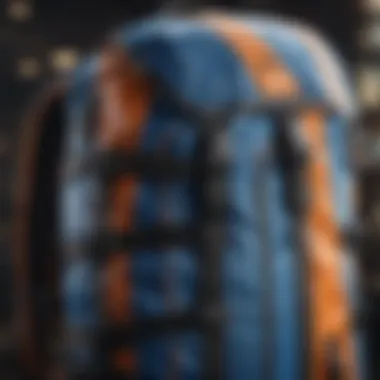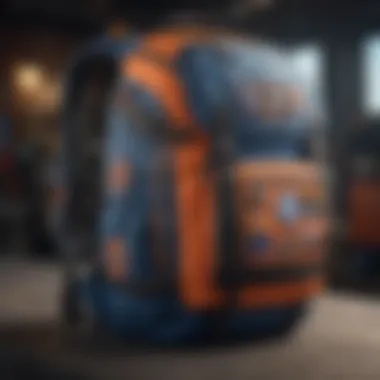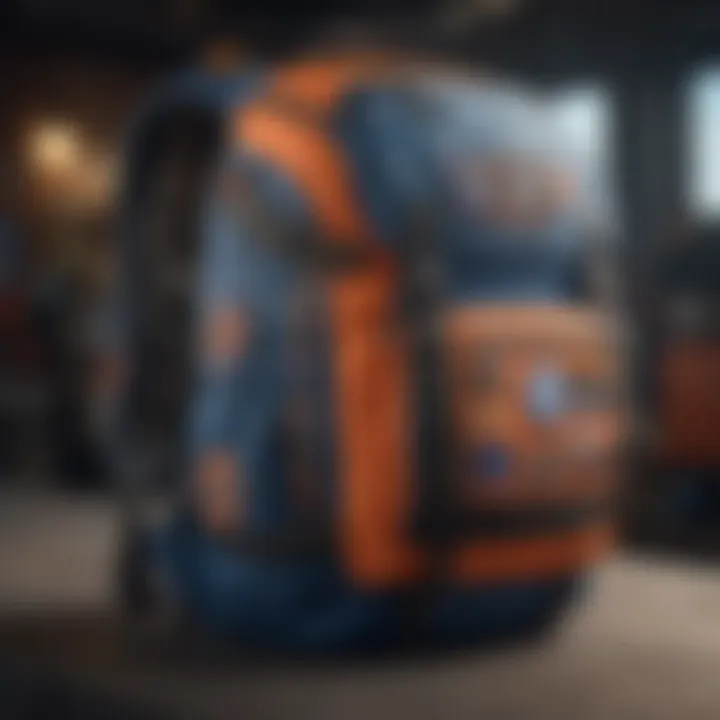Exploring the Blue and Orange Backpack in Extreme Sports


Intro
In the realm of extreme sports, where the thrill of the unknown meets the rush of adrenaline, every piece of gear tells a story—especially when it comes to backpacks. Among the vast array of options available, blue and orange backpacks stand out for several reasons. Not only do they serve as essential tools for carrying equipment, but their striking colors also convey a sense of identity and confidence. These hues are not merely aesthetic choices; they symbolize excitement and adventure, echoing the very spirit of the sports that enthusiasts engage in.
Exploring the significance of these backpacks reveals how they marry practicality with personal expression. In conversations with athletes, it becomes clear that their gear influences not just performance but also mindset. These backpacks, filled with the essentials for challenges yet to come, become extensions of their wearers—much like badges of honor worn into the wild.
By diving deeper into the material choices, individual preferences, and the emotional weight carried by a blue and orange backpack, we can better understand their dynamic appeal. Whether it’s scaling cliffs, tackling rapids, or traversing mountain trails, these backpacks enhance both the experience and the identity of the thrill-seeker.
Techniques and Tips
When it comes to selecting a backpack for extreme sports, there are a few techniques and valuable insights that can guide enthusiasts not only in choosing the right one but also in making the most out of their gear.
Skill Development
The first step in mastering gear usage is developing fundamental skills. If one is into rock climbing with a blue and orange backpack, it’s crucial to practice the basics of climbing technique. Knowing how to pack gear efficiently within the backpack can help streamline the climbing process, ensuring that all necessary tools are readily accessible in moments of need.
- Practice packing and unpacking your gear.
- Familiarize yourself with quick-release buckles and side pockets.
- Learn to adjust straps for maximum comfort and support.
Practical Techniques
Using a blue and orange backpack effectively requires a few practical considerations.
- Weather Resistance: Ensure your backpack has water-resistant materials. This feature can be vital during sudden weather changes that often occur in extreme sports settings.
- Weight Distribution: Learn to balance weight properly. Placing heavier items closer to the back helps improve stability and reduces strain.
- Accessibility: Organize essentials in external pockets for quick access. Keeping hydration packs easily reachable can make a world of difference during high-energy activities.
Common Mistakes to Avoid
When participating in extreme sports, avoiding certain pitfalls can enhance safety and performance.
- Don’t overload your backpack; it can lead to fatigue or injuries.
- Avoid using a backpack that doesn't fit your body frame; this can cause discomfort.
- Never overlook maintenance—regularly check straps, zippers, and materials for wear and tear.
Gear and Equipment
Choosing the right gear goes beyond just selecting a backpack. Understanding the broader spectrum of equipment used in extreme sports, particularly those that complement the blue and orange aesthetic, can significantly impact performance.
Essential Gear for Beginners
For novices, having the right foundational gear is essential. Beyond the backpack, here are necessities for anyone starting out in sports such as climbing or kayaking:
- Climbing Harness: Essential for any climber or mountaineer.
- Helmet: Crucial for protecting against falls or debris.
- Appropriate Footwear: Invest in shoes designed specifically for the sport.
Latest Innovations and Trends
The backpack market has seen an influx of innovative designs aimed at extreme sports. Notable trends include:
- Smart Backpacks: Equipped with tech features like built-in GPS and sensors to monitor performance.
- Eco-Friendly Materials: Increasing demand for sustainable options, appealing to environmentally conscious consumers.
- Adaptable Compartments: Allow for customized storage configurations for specific sports.
Reviews and Comparisons
When it comes to selecting the perfect blue and orange backpack, looking at individual reviews helps in making informed decisions. Numerous outdoor gear websites and forums provide comparative analyses highlighting various models such as the Osprey Atmos AG and The North Face Recon. Not only do they compare aspects such as price and durability, but they also cover user experiences that showcase functionality in extreme conditions.
Safety Measures
With adventure comes the necessity for safety. Understanding safety gear ensures that no moment of thrill ever goes amiss due to avoidable risks.
Essential Safety Gear
Mandatory safety gear varies depending on the sport but often includes:
- Personal Floatation Devices (PFDs): Vital for kayaking or canoeing.
- First Aid Kits: Always carry essential medical supplies.
- Emergency Beacons: Useful during hiking or remote expeditions.
Best Practices for Safe Participation
Safety should always be at the forefront of any adventure. Here are best practices to keep in mind:
- Always inform someone of your planned route and estimated return time.
- Stay within your limits but also push boundaries responsibly.
- Never underestimate the environment; respect all natural conditions to avoid hazardous situations.
Injury Prevention and Management
Avoiding injuries involves anticipating risks. Key strategies include:


- Warm-up exercises before engaging in any activity;
- Cooling down post-activity to reduce tightness;
- Knowing basic first aid can help in managing minor injuries quickly on-site.
Spotlights on Extreme Sports
Highlighting what’s generating buzz in the extreme sports world gives context to the appeal of these blue and orange backpacks. From pro highlights to emerging trends, here’s what to look out for.
Featured Sport of the Month
This month, let's shine a light on BASE jumping—an exhilarating sport requiring a serene blend of skill, precision, and a touch of daredevilry. Enthusiasts often choose vividly colored gear, such as blue and orange backpacks, to stand out in the air, making a statement as they leap off cliffs.
Profiles of Prominent Athletes
Famed athletes push the limits of what's possible in extreme sports, often becoming influencers in gear choices. Profiles of individuals like Felix Baumgartner or Yvonne Chaka Khan don’t just tell tales of their triumphs; they reflect personal aesthetics, showcasing how their choices enhance their extreme escapades.
"The right gear isn't just about protection; it's an extension of who you are during the ride of life, particularly in the extremities of sport." - Felix Baumgartner
By understanding these dimensions surrounding the blue and orange backpacks, enthusiasts can appreciate them not just as functional assets but as integral parts of their thrilling journeys.
Preface to Color in Adventure Gear
In the niche realm of adventure gear, color isn't just a frivolous choice; it plays a fundamental role. Beyond aesthetics, the shades chosen for backpacks can significantly affect visibility, personal expression, and even psychological readiness in the adrenaline-fueled world of extreme sports. When athletes gear up, the color of their equipment often reflects more than just style—it can signal a rider's affiliation, choices, and mindset.
Significance of Color in Sport Equipment
The colors used in sports equipment have much more significance than matching outfits with personal style. In extreme sports, dominant colors can enhance safety and visibility in environments that are often precarious. For instance, a bright orange backpack can easily catch the eye of a fellow climber on a foggy day, preventing potential accidents while also allowing for quick identification in turbulent landscapes.
Conversely, blue symbolizes calmness and stability, traits that are especially valuable in high-stress situations. When skiers navigate treacherous slopes or bikers tackle rugged trails, the color blue can provide a psychological buffer, helping to ground the user amidst the chaos. The combination of blue and orange thus serves a dual purpose—practicality in visibility and emotional preparation for confronting the wild.
Beyond safety, color can influence purchasing decisions. Extreme sports enthusiasts often gravitate toward gear that resonates with their personality or aspirations. A dazzling blue and orange backpack becomes a symbol, signifying a vibrant lifestyle filled with adventure and courage.
Psychological Effects of Color Choices
Color psychology also plays a pivotal role in how athletes perceive their environment and their own capabilities. Different colors evoke a range of feelings, impacting performance and behavior on the field or mountain. For example, research suggests that orange can stimulate feelings of energy and enthusiasm, potentially boosting performance levels during intense activities.
This energetic vibe is essential when adrenaline and exertion peak, propelling athletes forward as they challenge both their physical limits and mental barriers. Blue, on the other hand, can soothe nerves, allowing for a more calculated fixation on tasks in complex or dangerous outdoor settings.
In extreme sports, where every decision counts, these mental states facilitated by color can prove invaluable. Wearing a blue and orange backpack might enhance connectivity with beloved outdoor activities, simultaneously reinforcing a thrill-seeker's identity and heightening their focus.
"The colors we choose can influence actions and decisions, especially in extreme environments where every bit of clarity matters."
In summary, the introduction of blue and orange in adventure gear does not merely pop visually but resonates on deeper psychological and practical levels. This underscores why addressing the dynamics of color in extreme sports equipment should not be overlooked.
The Aesthetics of a Blue and Orange Backpack
The appeal of a blue and orange backpack goes beyond practicality. In the realm of extreme sports, aesthetics play a significant role in how athletes express their identity and commitment to their adventures. These colors not only stand out but also create a unique visual statement for adventurers who seek to blend functionality with personal style. The choice of design elements, color palettes, and patterns is crucial in making these backpacks desirable and representative of the extreme sports lifestyle.
Design Trends in Extreme Sports Gear
When it comes to extreme sports gear, the designs often reflect both the adrenaline of the activity and the vibrant spirit of its participants. Manufacturers now focus on producing bags that don't just serve the purpose of carrying gear but also make a bold fashion statement. Blue and orange backpacks have emerged as a popular choice, often featuring dynamic designs that mirror the environments where these sports take place.
- Geometric Patterns: Many designs incorporate bold geometric patterns that complement the energetic vibe of extreme sports. This gives the bag a modern touch, appealing to a younger audience.
- Functional Flares: Pockets and straps are not just placed haphazardly; they are positioned for ease of access while also enhancing the overall look of the backpack.
- Integrated Technology: Some brands are now innovating with features like built-in hydration systems, which blend seamlessly into the bag's design.
This trend showcases how the blue and orange color scheme fits into larger aesthetic movements, emphasizing not only visual appeal but also a user-centered approach that caters to the practical needs of extreme sports aficionados.
The Visual Impact of Color Combinations
Color choices form a critical part of any item's appeal, especially in the adrenaline-pumping world of extreme sports. The blue and orange combination stands out remarkably against various natural backdrops, whether it's the rocky mountains or lush forests. The contrast created by these colors not only draws attention but can also affect mood and motivation.
Research suggests that blue is often associated with calmness and stability, making it a favorite choice among athletes seeking to harness focus in high-pressure situations. On the other hand, orange evokes feelings of enthusiasm and vitality. Together, they create a dynamic visual synergy that can boost confidence and camaraderie among users.
- Visibility: In extreme conditions, the bright orange pops against earthy tones, enhancing visibility for safety. This is an essential factor, especially in backcountry settings.
- Personal Expression: Beyond safety and performance, color combinations allow athletes to express their personality and preferences, supporting a sense of belonging in the community.
"The colors we choose often reflect who we are, and in extreme sports, they can represent bravery and camaraderie."
Thus, the aesthetic choices surrounding blue and orange backpacks not only fulfill visual appeal but also play a pivotal role in the broader narrative of identity and performance in extreme sports.
Functional Aspects of the Blue and Orange Backpack
When it comes to extreme sports, the ideal gear must strike a delicate balance between performance and aesthetics. The blue and orange backpack serves as a remarkable example of this intersection. Functionality burns bright amid vibrant colors, offering adventurers more than just a striking look. Here, we will delve into material considerations and notable storage solutions that make these backpacks indispensable for thrill-seekers.


Material Considerations for Durability
Durability can’t be an afterthought when it comes to a backpack that’s expected to endure the rigors of extreme sports. These are not your run-of-the-mill backpacks; they’re crafted from materials designed to take a beating.
- Weather Resistance: Fabrics like Cordura nylon or ripstop polyester give the backpack water resistance without adding unnecessary weight. When you're scaling a rock wall or navigating through a rainstorm, the last thing you want is your gear soaking through.
- Reinforced Stitching: Durable stitching techniques, such as double or triple stitching, ensure that seams won’t give out under stress. The blue and orange backpack often incorporates heavy-duty zippers and reinforced stress points, which is crucial during rigorous adventures.
- Lightweight Yet Strong: The best materials are often an intricate dance between weight and strength. These backpacks often utilize lightweight composite materials that don't compromise on durability. This means athletes can pack their gear without lugging around unnecessary weight.
A backpack that combines these materials offers peace of mind for those who push the limits in their pursuits.
Storage Solutions for Adventurers
The convenience of smart storage features can elevate a blue and orange backpack from just eye-catching to indispensable. A design that embraces practical storage will cater to the needs of adrenaline junkies.
- Multiple Compartments: Having various compartments isn't just about organization; it's also about easy access. When you’re out, it’s vital to quickly grab that snack or camera without fumbling about. A well-placed side pocket or front compartment can make all the difference.
- Hydration Features: Many models are equipped with hydration reservoirs, which keep adventurers hydrated without needing to stop frequently. It’s convenient and efficient – merge that functionality with a flamboyant blue-and-orange color scheme, and you have a winning combo.
- Modular Attachment Points: For those who might want to attach extra gear, be it climbing ropes or sleeping bags, look for backpacks that feature compatible loops or clips. This adds versatility and flexibility, making the blue and orange backpack suitable for various activities.
In summary, the functional aspects of the blue and orange backpack extend far beyond mere aesthetics. With durable materials and clever storage solutions, it ensures that extreme sports enthusiasts can tackle any adventure without skipping a beat. Its design encapsulates the essence of adventure, combining practicality with a vibrant flair that truly stands out in a sea of standard equipment.
Color Symbolism in Extreme Sports
The interplay of color in extreme sports goes beyond mere aesthetics; it speaks to the deeper meanings and emotional responses tied to specific shades. Color symbolism is paramount in understanding how athletes connect with their gear, particularly with backpacks that are both functional and visually striking. When exploring the blue and orange backpack, these colors hold significant meaning that can influence both performance and identity for adventurers. The colors selected for gear can invoke feelings of calm or energy, resonate with personal values, or even enhance visibility in high-energy environments.
The Meaning Behind Blue
Blue is a color often associated with tranquility and stability. For athletes engaged in extreme sports, such as rock climbing or white-water rafting, a blue backpack embodies calmness amidst chaos. It’s a color that paints systems of loyalty and trust, perhaps reflecting the bond one has with their team or nature itself.
In practical terms, blue enhances visibility against various landscapes—think of a clear blue sky contrasted against the rugged browns of a mountain range. When thrill-seekers find themselves in precarious situations, having gear that stands out can be a lifesaver.
- Psychological Stability: The soothing nature of blue can help athletes maintain focus during intense moments.
- Adaptable Aesthetic: Blue works well across various environments, offering versatility without sacrificing style.
- Cultural Links: In many cultures, blue denotes wisdom and confidence, qualities that are invaluable in extreme sports.
"Color can greatly affect mood and confidence, particularly in challenging sports. Blue may just be the calming influence athletes need in the bleachers of thrill-seeking."
The Impact of Orange
Contrasting with the calm essence of blue, orange is charged with vibrancy and enthusiasm. It embodies energy, adventure, and encouragement. The orange backpack becomes a beacon calling to adventure, stirring feelings of excitement. In the wild, it’s almost impossible to miss an orange backpack through the trees or against rocky terrains. This functionality not only serves a practical purpose, enhancing safety but also amplifies the psychological edge of an athlete.
- Visibility: The bright hue ensures that athletes are easily spotted, crucial in rugged terrains or during rescue operations.
- Energetic Vibes: Orange can uplift spirits and boost confidence, facilitating a more spirited approach to challenging feats.
- Social Significance: Orange is often linked to communal activities and teamwork—qualities that mirror the spirit of adventure sports.
In summary, the colors blue and orange do not merely beautify a backpack; they carry with them the essence of the experiences and values cherished by extreme sports enthusiasts. The symbolism attached to these shades can forge a stronger connection between the athlete and their gear, enhancing both performance and emotional satisfaction.
Examining User Experience
When it comes to extreme sports, the rigors faced during high-octane activities mean that user experience cannot be an afterthought. The blue and orange backpack isn’t just a stylish accessory; it’s a necessity that molds to the way thrill-seekers operate. Understanding how these backpacks mold to user needs showcases their importance in enhancing performance, comfort, and overall satisfaction.
First and foremost, durability takes precedence. Extreme athletes often find themselves in rugged terrains where only the toughest gear can hold up. Through direct feedback, we can see that many sports enthusiasts favor the blue and orange backpacks for their robust materials. They withstand the harsh conditions of mountain climbing, the dampness of kayaking, and chaos of dirt biking. Additionally, the thoughtful integrations including pockets and straps tailored for climbing gear or hydration packs reflect a keen attention to usability.
Another core aspect of the user experience relates to comfort. Strapping on a backpack that is both functional and comfortable is crucial. Reviewers often note the padded straps and back panels that ensure ease while moving. This can’t be stressed enough, as a well-fitted backpack not only prevents fatigue but enhances the overall thrill of the ride or hike. In many cases, users have remarked how less bulky packs enabled them to maintain agility which is vital for performance – demonstrating that every layer of design counts.
The blue and orange color combination also emerges as a key player in the overall experience. Athletes often emphasized that visibility is non-negotiable in extreme conditions where the elements can shift rapidly. Bright orange stands out against the backdrop of nature, allowing for quicker retrieval or recognition in low-light situations. The emotional response tied to these colors can also play into this narrative. A backpack that instills confidence due to its color and appeal can elevate sheer engagement with the activity.
"User experience goes beyond material functionality; it’s about trusting the gear that becomes a part of your journey."
Ultimately, the conversation about the blue and orange backpack in extreme sports marries form and function. Collecting insights directly from users allows brands to innovate while ensuring that they meet the changing needs of extreme sports enthusiasts. As these experiences are shared within communities, they foster a loyalty not easily achieved through traditional marketing alone. It’s this confluence of feedback, evolving demands, and the capability of the backpack that shapes its continued relevance in an ever-changing market.
Personalization Trends and Customization
In the realm of extreme sports, where individuality often takes center stage, the trend of backpack customization has found significant traction. These backpacks, specifically in the unique blue and orange color combination, represent more than just equipment; they tell a story about the wearer. Personalization in gear has become not only a fashionable statement but also an avenue for self-expression. As thrill-seekers engage in their daring pursuits, they want their gear, like their identities, to stand out from the crowd. This inclination towards customization infuses each backpack with a layer of personal significance that resonates deeply with users.
Customization offers various benefits. When athletes incorporate their designs, they enhance their connection with the gear. A blue and orange backpack, adorned with personal symbols or messages, can inspire confidence and bolster a sense of ownership. Moreover, it allows for the merging of practicality and style. Athletes can select pockets, straps, and accessories that cater to their specific needs while also expressing their creativity. This useful approach to design brings forth a functional aesthetic, marrying the best elements of both worlds.
Adding Personal Touches to Gear
Adding personal touches to gear is a delightful journey of creativity for extreme sports enthusiasts. Think of it as a craft project where the backpack becomes a canvas. Athletes can choose to sew patches representing their favorite locations visited during adventures or add embroidered names or mottos that motivate them during challenging climbs or rides.
There are some popular options for personalization:
- Patches: These can be sewn or ironed onto the backpack, showcasing personal achievements or beloved brands.
- Custom Colors: While blue and orange are striking, mixing in a few custom hues or patterns can heighten the visual interest.
- Printed Designs: Some brands allow customization through print, whether it be team logos, personal artwork, or motivational quotes.
Such alterations not only make the backpack aesthetically unique but can also serve practical purposes. For instance, personalized pockets can be added for easy access to frequently used items. Athletes often prefer gear that caters to their individual routines, and a personalized backpack speaks directly to that need.
Influence of Social Media on Customization


In recent years, the impact of social media on customization trends has grown exponentially. Platforms like Instagram and Facebook provide prime real estate for showcasing unique gear. Users often post pictures flaunting their personalized blue and orange backpacks, inspiring others to explore how they can make their own gear distinctive. This cycle of inspiration breeds creativity, pushing athletes to elevate their styles and add personal elements to their gear.
Social media also serves as a powerful feedback mechanism, allowing users to gather opinions on their designs. It’s not uncommon for extreme sports enthusiasts to develop ideas, run polls on their platforms, or even host contests to engage their followers in their customization journey. The sense of community on these platforms reinforces the idea that personalization is not just an individual endeavor but is rooted in shared experiences.
As excitement around the customization of backpacks continues to grow, it reflects larger social trends. Individuals are looking for ways to express themselves in every aspect of their lives, and in extreme sports, where identity is crucial, a personalized backpack serves as a tangible manifestation of that quest for individuality.
Sustainability Considerations in Backpack Design
In recent years, the concept of sustainability has taken center stage in various industries, and the world of extreme sports gear is no exception. Given that adventure activities often occur in pristine environments, it's crucial to consider how the gear we use impacts both the planet and the ongoing adventure. A backpack, specifically one that's designed for high-octane outdoor activities like rock climbing, mountain biking, or snowboarding, serves not just as a functional piece of equipment but also as a reflection of the user's values regarding environmental responsibility. Today, consumers increasingly seek out backpacks that harmonize performance with sustainability, echoing the growing global call for eco-friendly products.
The blue and orange backpacks, in particular, provide an exciting opportunity for brands to showcase these sustainable practices. Not only do they attract attention due to their vibrant colors, but they also stand as symbols of a commitment to environmental stewardship. Essential elements to consider in sustainable backpack design include:
- Material choice: How materials are sourced and processed is pivotal.
- Durability: A well-made backpack reduces the need for frequent replacements, which can have detrimental effects on waste.
- Recyclability and biodegradability: Backpack designs that allow for easy recycling help minimize landfill impact.
Eco-Friendly Materials and Their Benefits
The materials used to manufacture a backpack greatly influence its ecological footprint. Modern innovations have made it possible to produce high-quality backpacks from eco-friendly materials without sacrificing performance. For example, recycled polyester, derived from used plastic bottles, is becoming a popular choice. Not only does it reduce waste, but it also conserves resources that would otherwise be consumed in the production of virgin polyester.
Here are some key benefits of utilizing eco-friendly materials in backpack manufacturing:
- Reduced environmental impact: Eco-materials typically use less energy and produce fewer greenhouse gases.
- Enhanced image among consumers: Brands that adopt sustainable materials often see an uptick in consumer loyalty and positive brand perception.
- Performance: Many eco-friendly materials are high-performing, offering durability and resistance to the elements.
Incorporating these materials into blue and orange backpack designs allows thrill-seekers and adventure lovers to align their gear with their values, thereby enhancing their overall experience.
Impact of Sustainable Practices on Brand Image
The rise of eco-consciousness has led to a shift in customer preferences, where many consumers, especially in the extreme sports community, are increasingly supporting brands that embrace sustainable practices. This trend creates a significant competitive advantage for companies producing blue and orange backpacks. Building a reputation for sustainability can bolster a brand’s image, making it more attractive in a crowded market.
Adopting sustainable practices sends a strong message and differentiates brands in a few vital ways:
- Attracting a loyal customer base: Many consumers choose to remain faithful to brands that demonstrate commitment to sustainability.
- Positive media attention: Sustainable practices often garner favorable coverage, increasing visibility and brand awareness.
- Attracting partnerships: Other companies recognize the value of partnering with eco-friendly brands, leading to collaborative projects that further enhance brand image.
“When brands focus on sustainability, they not only protect the environment but also cultivate a dedicated following that values responsible consumption.”
Market Trends in Extreme Sports Backpacks
The realm of extreme sports is no stranger to the ever-evolving fashion landscape, as the backpack has become an essential piece of kit. In the high-stakes world of thrill-seeking activities, where every ounce matters, the backpack mustn't just function, it must resonate with the wearer's identity. This section dives into the pulsating heart of the market trends shaping these backpacks, especially those flaunting the eye-catching blue and orange hues.
Emerging Brands and Innovations
In recent years, a handful of emerging brands have been making waves by introducing innovative design features and materials. Companies like Patagonia and Osprey have cultivated reputations for quality, but newer players, such as Hydro Flask and Badlands, are carving niches by focusing on unique selling points. Innovation is not just a cherry on top; it’s the driving force that attracts avid adventurers. Here are some trends that stand out:
- Hybrid Materials: Brands are increasingly adopting hybrid materials that offer enhanced durability while remaining lightweight. This is critical for extreme sports where gear is harshly tested by exposure to the elements.
- Modular Designs: Consumers are seeking flexibility, with modular designs allowing backpacks to be customized on-the-go. This trend reflects the modern adventurer's desire for versatility and personalization.
- Tech Integration: With tech being an integral part of our lives, some backpacks feature solar panel charging, waterproof pockets for electronics, and built-in hydration systems, appealing directly to a tech-savvy audience.
"Gear is what keeps us connected to the wild; it should work hard without dragging us down."
– An avid climbing enthusiast
These innovations don't just catch the eye; they signal a cultural shift towards more functional and aesthetic gear, creating a snowball effect where brands compete to outdo one another.
Consumer Preferences: Trends Over Time
Historical context plays a pivotal role in understanding current consumer preferences in the backpack market. The rise and fall of different colors, styles, and functionalities can often be traced back to broad shifts in lifestyle and technology. Over the past decade, consumers have shown a distinct interest in:
- Sustainability: The appeal of eco-conscious products has never been stronger. Consumers are leaning towards brands that showcase sustainable practices in their manufacturing processes. This shift demonstrates a collective responsibility among adventurers to protect the environment while enjoying nature.
- Aesthetic Appeal: The vibrant combination of blue and orange has gained traction, appealing to those looking to stand out in a crowd. It’s not merely about function anymore; it's also about making a statement.
- Social Media Influence: Many enthusiasts are influenced by what they see on social platforms. This has driven brands to curate images that present their backpacks in real-life contexts, fostering an emotional connection with potential buyers.
The conversation around consumer preferences often reflects a deeper desire for individuality. Individuals aren’t just buying backpacks; they're investing in a lifestyle.
In sum, keeping a pulse on these market trends not only highlights the competitive edge for brands but also helps adventurers make informed choices about the gear they carry. The backpack is an extension of an adventurer’s identity—its colors and features signify who they are and how they engage with their beloved extreme sports.
Finale: The Future of Backpacks in Extreme Sports
As we look ahead, it’s apparent that the role of backpacks in extreme sports is evolving rapidly. This article has highlighted not just the significance of the blue and orange color way but also its functional, aesthetic, and psychological influence on athletes. The trends in design, user customization, and materials are not just passing phases; they’re setting a precedent for future gear. Today’s thrill-seekers are demanding more from their equipment—not only in terms of performance but also in personal expression and sustainability.
Evolving Designs and User Needs
This segment brings to light how backpack designs must adapt to the continuous change of user demands. Athletes are not a monolithic group; their needs often diverge based on the specificities of their sports, be it climbing, snowboarding, or paragliding. Functional elements such as hydration reservoirs, ergonomic fits, and compartmentalized storage will always be paramount. However, there's also a noticeable shift towards making gear more personal.
With extreme sports deeply rooted in individuality, customization becomes crucial. Users often seek ways to differentiate their gear in a world where performance gear can look quite similar. The blue and orange backpack resonates well with this because it offers visual spice while maintaining practical advantages. Moreover, it has the potential to influence upcoming design narratives—it could foster innovations that refine utility without compromising style.
The Lasting Impact of Blue and Orange in the Extreme Sports Community
The blue and orange color combination is not merely a trend. It has become a staple within the extreme sports landscape, impacting community identity profoundly. These colors are often associated with adrenaline, ambition, and adventure. When athletes don these backpacks, they’re not just packing gear; they're projecting a culture.
This color palette is now synonymous with bold choices, echoing in the rites of passage that extreme sports fans celebrate. The backpack transcends its utility; it becomes a badge of loyalty to the sport and a visual representation of one’s adventurous spirit. It holds memories of escapades gone right—and some that didn’t quite hit the mark.
"In every adventure, the journey is as vital as the destination, and a backpack can become a part of that saga."
The incorporation of blue and orange within the extreme sports community shows how color can catalyze camaraderie among athletes. It fosters a sense of belonging while empowering them to embrace challenges, much beyond what is typically packaged as ‘just gear.’ Ultimately, the future of backpacks in this energetic field is rich with possibility, suggesting that as sports evolve, their equipment will too, closely reflecting the vibrant tapestry of the extreme sports culture.







